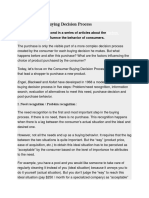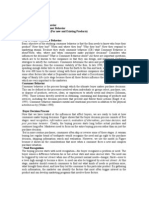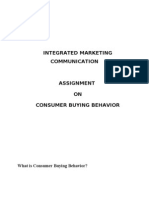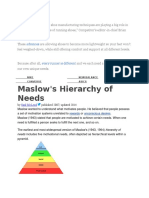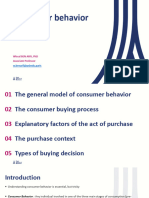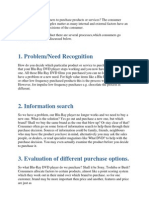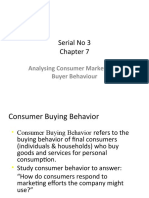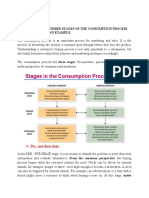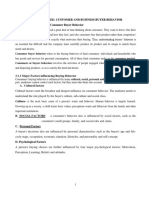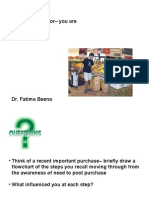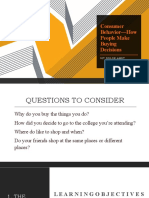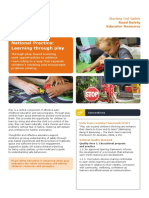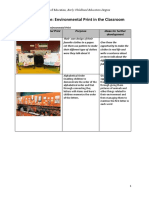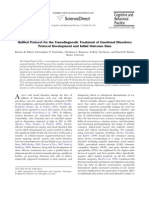Marketing individual assignment:
Table of content xxxxxxxxxxxxxxxx
1.0 Consumer Buyer Decision Process
Introduction How customers make their purchase decision is a very important issue for a companies marketers. It can bring numerous influences to companies for establishing an appropriate marketing strategy. Therefore, the research of each stage of buyer decision process is relevant for all the marketers. A researchers point out that the setting up of buyer decision process model can help managers to understand and forecast consumer behaviors, and thereby they can make effective decision for providing more acceptable offers to customers. Kotler, Brown, Burton, Deans and Armstrong (2010) also hold the same view and state that there are five main steps of buyer decision process, as drawed in Figure 1. Firstly, consumer decision process starts from realizing to distinguish factual state and desired state (problem recognition), and then seeking useful information to solve the problem (information search). Next evaluating and examining the information (evaluation of alternatives) , making the final decision on what to purchase (purchase decision) and lastly feedback on the item purchased (post purchase behavior). The figure suggested that consumers pass through all five stages with every purchase. But in reality purchases, consumers often skip or reverse some of these stages. However, we use the model in figure 1 because it shows all the considerations that arise when a consumer faces a new and complex purchase situation like what I'm going to explain in my recent purchase in the next few page.
Figure 1 Need recognition > Information search > Evaluation of alternatives > Purchase decision > Post purchase behavior
1.1 Need recognition: The buying process starts with need recognition where the buyer recognizes a problem or need to buy something. The need can be triggered by internal stimuli
�when one of the person's normal needs like hunger with wanting to eat something or thirst by wanting to drinks water. A need can also be triggered by external stimuli. For example, an advertisement might get us to think about buying a new car. 1.2 Information search An interested consumer may or may not search for more information. If the consumers drive is strong and a satisfying product is near at hand, the consumer is likely to definitely buy it. If not, the consumer may store the need in memory or undertake an information search related to the need. for example, once i've decided i need a new car, at the least, i will probably pay more attention to car ads, cars owned by friends or celebrity, and talking about car. Or I may actively look for reading material, phone friends, search in the internet, and gather information in other ways. The amount of searching I do will depend on the strength of my drive or desire, the amount of information i start with, the ease of obtaining information for more information, and the satisfaction I get from searching a information. Consumers can obtain information from several sources like personal sources which is friends and family, commercial sources which is from advertisement , sales people or websites, public sources which is known as the mass media and experiential sources which is using the the product. As more information is obtained, the consumer's awareness and knowledge of the available brands and features increases. 1.3 Evaluation of alternatives It is the stage of the buyer decision process in which the consumer uses information to evaluate alternative brands in the choice set. The consumer arrives at attitudes towards different brands through some evaluation procedure. In some case, consumers use careful calculations and logical thinking. Sometimes consumers make buying decisions on their own , and sometimes they turn to friends, consumer guides or sales people for buying advice. Suppose if I wanted styling attributes of a product , I would buy the car that I think has the best styling. But most buyers consider several attributes, each with different importance. 1.4 Purchase decision In the evaluation stage, the consumer ranks brands and forms purchase intentions. Generally, the consumer's purchase decision will be to buy the most preferred brand, but two factors can come between the purchase intention and the purchase decision. The first factor is the attitudes of others. If someone important to me thinks that I should buy the lowest-priced car, then the chances of my buying a more expensive
�car are reduced. The second factor is unexpected situational factors. The consumer may form a purchase intention based on factors such as expected income i get, expected price offered, and expected benefits. However, unexpected events may change the purchase intention. For example, the economy might take a turn for worse, a close competitor might drop it's price, or a friend of mine might report being disappointed in my preferred car. In short, preferences and even purchase intentions do not always result in actual purchase choice. 1.5 Post purchase Behavior After purchasing a product, the consumer will be satisfied or dissatisfied and will engage in post purchase behavior of interest to the marketers. What determines whether the buyer is satisfied or dissatisfied with a purchase is the relationship that lies between the consumer's expectations and the product perceived performance. If the product falls short of expectations, the consumer is disappointed. While if it meets expectations, the consumer is satisfied and if it exceeds expectations, the consumer is delighted. The larger the gap between expectations and performance, the greater the consumer's dissatisfaction. Almost all major purchases result in cognitive dissonance, or discomfort caused by post purchase conflict. That is why it is important to satisfy the customer because it is the key to building a profitable relationships with customer .
2.0 My recent purchase
When I first enrolled at Inti University, I am provided with an acer laptop which I have had over the years since I was in form 2. While the computer was sufficient for very basic tasks, it was slow and caused a relatively large bottleneck in my computing productivity. When I enrolled at Inti University during the August intake of the 2010 semester, the size and weight(by forcing me to just place it on my desk) and age (most of the
�crucial parts, such as CPU and RAM are 8-9 years old) of my existing laptop made taking assignment a more difficult task than it needed to be. This was the beginning of the first phase of the consumer decision making process, problem recognition. As someone who has knowledge in computers, it was definitely not my ideal situation to have a 9 year old laptop at home that was barely capable of performing anything beyond basic tasks. The build up of laptop frustration over the months finally led me to admit that I would need to either heavily upgrade my existing computer or buy a new laptop. These situation can be perfectly linked to the
Maslows Hierarchy of Needs theories. Whereby, Abraham Maslow
hierarchy of needs theory sets out to explain what motivated individuals in life to achieve. He set out his answer in a form of a hierarchy. He suggests individuals aim to meet basic psychological needs of hunger and thirst. When this has been met they then move up to the next stage of the hierarchy, safety needs, where the priority lay with job security and the knowing that an income will be available to them regularly. Social needs come in the next
�level of the hierarchy, the need to belong or be loved is a natural human desire and people do strive for this belonging. Esteem need is the need for status and recognition within society, status sometimes drives people, the need to have a good job title and be recognised or the need to wear branded clothes as a symbol of status. Selfactualisation the realisation that an individual has reached their potential in life. The point of self-actualisation is down to the individual, when do you know you have reached your point of self-fulfilment? But how does this concept help me on my recent purchase? Well as Maslows concept suggests that needs change as we go along our path of striving for self-actualisation. The technology market nowadays develop value brands to meet the psychological needs of our needs. Apple Macintosh develops products and services for those who want have met their needs. So Maslows concept is useful for me as it has helps me to understand and develop my own needs and wants. (Kotler. 12 e. P135)
Once I admitted the gap between my ideal and actual situation,
�I still had to decide whether I wanted to upgrade my laptop RAM or buy a laptop. I did not wish to buy a new desktop computer as it did not provide enough value for me plus i can't bring it anywhere with me. If I was going to buy a laptop, I wanted to buy one that would be excellent in power, multitasking, design and features. From my previous experience with the Acer laptop, I eliminated acer brand laptops from my possible options. I was still faced with a huge range of products, so I had to further limit my options. I then began to identify which parts of my existing computer would have to be upgraded if I was to go that route. After researching parts and prices on web-sites, I determined that the cost of upgrading my existing heavy laptop would not be worth it as Id still be locked into using the computer at my desk because of its weight. Portability became one of my most important criteria for my new computer due to having less time to get all of my computing done at my desk at home due to studying full-time while also trying to maintain a social life in social networks and online shopping. I actually have responded in a particular stimuli in a different ways after the stimuli have processed in my mind. It is called the black box theories whereby it is known as 'The black box' because we only know a little on how the human mind works. You cannot see what goes on my mind and you really don't know about how much going on there. I know enough to be able to identify some major internal influences but I really don't now how I transform all these data, together with the stimuli to generate this tasks. (Kotler et al. .2004.Chapter
�7, pp. 242-244, 'Consumer behaviour' and 'A model of consumer behavior')
I then began researching the latest laptop models and repeatedly became frustrated at the lack of one laptop which met all of my needs. My acer laptop proved to be very unreliable and not durable thus reliability and durability were also important factors for my new computer. Reading reviews online, I just could not find a laptop which was fast, reliable, durable and had a good cost to features ratio. A few months ago, one of my friends dads picked up an Apple Macbook from Apples store. Seeing the Macbook in person, I was amazed at how small the computer was. The friend whose dad purchased the Macbook is a software release engineer. He advised me that I should try out Macbook for the laptop I decided on buying. I decided I was ready for a full on transition to Apples Mac OS X operating system runs off a Unix core as another benefit of an Apple laptop. I could learn Unix, which would greatly ease while still being able to use a very intuitive and end-user friendly operating system for my necessary tasks . I then researched the Apples latest laptops for durability, reliability, performance and a multitude of other factors to determine how much benefit I would receive in exchange for the cost of an Apple laptop. I was very much on the border of whether an Apple computers higher cost was worth it. I found several other brands which were comparable to the Macbook and Macbook Pro in terms of performance and features. The HP
�Pavilion, and Toshiba Satellite, all had Intel Core 2 Duo processors and more memory, hard drive space, and better video graphics cards than the Macbook line of laptops. Sony also had laptops with seemingly great features and benefit to cost ratio, however, my poor personal experiences and history with Sony CD players, video game systems and several other products immediately eliminated Sony from consideration. While the Windows based laptops from HP, and Toshiba appeared on the surface to be much better deals, I dislike the Microsoft operating system and was heavily valuing Apples use of Unix based operating system. Having placed a heavy value on the Mac OS X operating system made it very tough for the alternative laptops I had identified to be chosen. Deciding by elimination, left me with the choice of whether to buy a Macbook or Macbook Pro and even after that choice, of which configuration to choose. From admitting my problem to the point of deciding to go with an Apple laptop took approximately one to two months of research and analysis. Although I had traversed the tough and time-consuming steps of the consumer purchase decision process, I was still a ways off from making a purchase. Upon realizing that the Macbook Pro uses an aluminum case rather than the plastic case on the Macbook, and the Macbook Pro utilizes a stand alone graphics card whereas the Macbook has its graphics chip built into the motherboard focused my attention on the Macbook Pro. At this point, I also decided that
�the cheapest configuration for the Macbook Pro was a better value than the more powerful but more expensive configurations. Having decided to buy a Macbook Pro, I knew I would be buying my laptop from Apple and after deciding that a brand new laptop with a great value for my money, I knew Id be going to an Apple Store to buy a Macbook Pro. My last decision was when to buy a Macbook Pro. Having discovered through my earlier research that Apple was very close to completing the new version of their Max OS X operating system, Leopard, made me want to wait until the new operating system was released to avoid the costs of upgrading later and to have the latest version of the operating system when I bought my laptop. After further consideration, I decided its best to let a few releases of Leopard to roll out so Apple can make and necessary improvements and fix any bugs. I quickly acclimated to the Mac OS X operating system and picking up some knowledge of Unix. I noticed the sharp increase in performance on my desktop computer has caused me to experience some cognitive dissonance with my purchase of a Macbook Pro. However, the performance of the Macbook Pro and the included software is for the most part so excellent and superior to the other brands I had considered, that I am still pleased with my Macbook Pro.
Lastly, while I have not obtained the iPad yet, I can infer on my post purchase behavior. I may be happy
�with my newly acquired iPad, and for Apple to keep me happy, I assume they will come up with new apps, more tools to few videos, and constant updates to keep the iPad as exciting of a product as possible as they have done in the past with their other products.
Analysis On Business Buying Behavior Of Laptop: A Study Of Educational Institutes
STATEMENT OF THE PROBLEM: The present paper aims at finding the institutional consumer behavior. The research problem investigated here in has been precisely defined as- Analysis of Business Buying Behaviour: A study of Educational Institutes based on empirical research. RESEARCH OBJECTIVES: The research objectives of this study are stated as below:1. Factors affecting the buying behavior of laptops. 2. Determination of customer satisfaction level in regard to various brands. 3. Perception & awareness level of all companies in the market.



